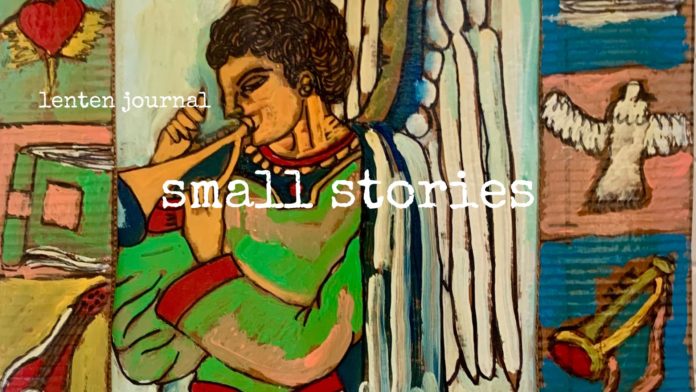Tonight we ate dinner at 2 Chefs Gullah Geechee restaurant in Savannah. Morolayo Akinrinnola and OriBemi Adetutu are the chef owners (and are married to each other), and they were the ones in the kitchen cooking all the goodness that graced our plates. Mine included fried chicken, collard greens, macaroni and cheese, and rice with gravy. Oh–and a cinnamon roll right out of the oven that was legendary.
But I am getting ahead of myself. That’s how we finished the day.
We began by letting Johnnie Brown take us on a two-hour Black history tour of Savannah, which included a number of stops and an incredible amount of information, but the highlight was visiting the Beach Institute, which was founded in 1865 as the first official school for African-Americans in Savannah. Today it is Savannah’s flagship museum for African-American arts, history, and cultural preservation. We saw exhibits showcasing the art of Rudolf Valentino Bostic, a folk artist who painted on cardboard with discarded house paint because he didn’t have money to buy supplies, and the wooden sculptures of Ulysses Davis, a barber who “whittled” in his spare time to create amazing work.
From there we went to lunch at Rancho Allegra, a family-owned Cuban restaurant that started in a house twenty years ago and now offers not only great food but is an important live music venue in the city. The food was flavorful and interesting. The people were friendly and kind. It was good to be there.
We then drove about eight miles out of town to the Pin Point Heritage Museum, which is located in the old A. S Varns and Sons Oyster and Crab Factory. We sat in the rooms where they had picked crab and shucked oysters hour after hour and listened to Gail, a woman who had worked in the factory as a child, tell us about how the people who worked there found ways to buy the land and establish their community, in large part around the Sweetfields of Eden Baptist Church. The community dates back to 1896. The land has remained in the hands of the descendants of those folks ever since, making it the largest amount of Black-owned waterfront property in Georgia, and one of the most cohesive Gulla-Geechee communities left in America.
We watched a documentary about the oyster and crab factory, looked out across the Moon River (named in honor of Johnny Mercer, who was from Savannah) and the marshes, and listened to Gail tell stories as we stood in the places where folks had done such backbreaking work for very little pay. The spirit of the people shone through in all of it. Gail also told us some of her story–how her mother and father got her through college, and how she found her way back to work in the museum because she wanted people to know the story.
Then we went to dinner. I’ve already told you about the food–well, my food. Others had fried shrimp, red rice, smothered shrimp, and most all of us had cinnamon rolls. After dinner, I asked Chef Morolayo if they could come talk to us for a minute. She told us about Gulla-Geechee food and how she had learned to cook from her grandmother. She also talked about Pin Point, and when we said we had been to the museum earlier, she said, “Did y’all meet my cousin Gail?”
That also seemed to open her up to share more about their life and how the restaurant came to be. She had a catering business that she had to close. Her husband was also struggling. They had lost everything, she said. They both decided to go to a culinary school they saw advertised on television, both got scholarships, and both got their certifications. Then they opened the restaurant. The other astonishing detail was they had eleven children, ranging from age thirty-one to five. Through all her story, it was clear that this was a woman who loved her life, as hard as it might have been, which was also what it felt like to look at Bostic’s paintings, or Davis’ woodwork, or hear Gail talk about why Pin Point mattered so much.
Some of our group were talking after we got back to the hotel, and it struck me that it’s not so much the actual circumstances of our existence as it is how we tell the story of our lives. None of the places we were in today are thriving in the sense that they feel secure about their future. Neither of the restaurants have webpages. Though the works of both Bostic and Davis have gained in value, both men died without their art doing much for them financially. Each one of their stories could be told as though their presence on the planet was incidental to humanity, just as the story of our trip from Connecticut could be told as though it won’t make a difference in the quest for equity and belonging in our country.
But that’s not the way the people we met told their stories. They told their small stories like they matter–and they do. Fame is not the same as significance any more than wealth and intelligence are synonyms.
The world is made of small stories of significance, of lives built of cardboard and wood chunks, of oyster shells and cinnamon rolls, all of them reminding us there is enough love–enough of everything–to go around if we are willing to share it.
Peace,
Milton

“Fame is not the same as significance any more than wealth and intelligence are synonyms.”
I will hold these words in my heart. Thank you.
Your closing paragraph brought a lump to my throat and tears to my eyes. Painfully beautiful, painfully told.